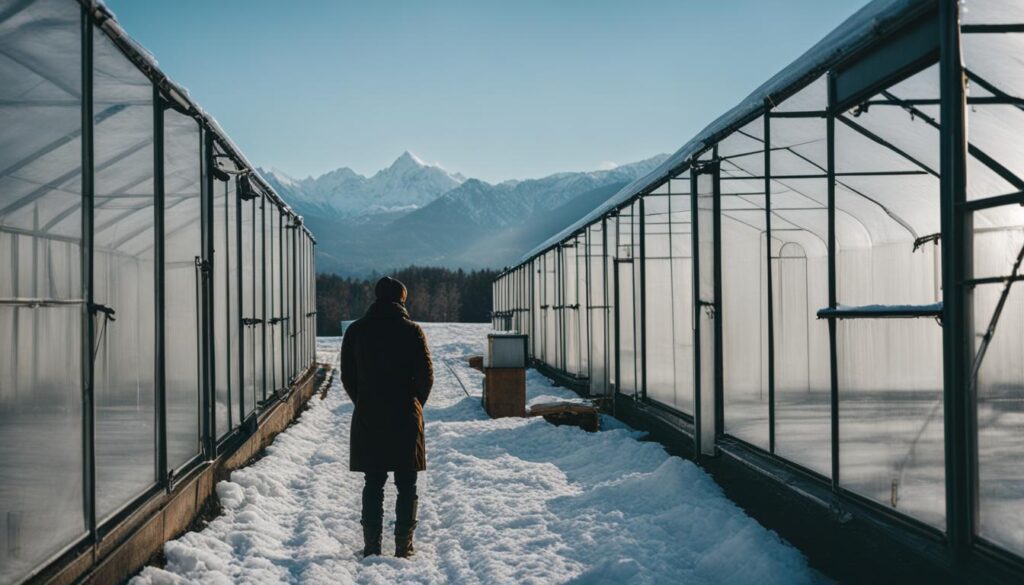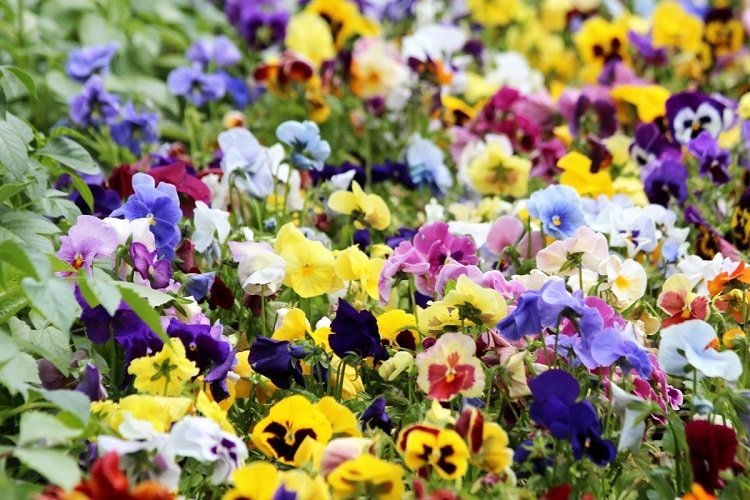Greenhouses are an essential resource for gardeners looking to extend the growing season and maintain healthy plants throughout the winter months. With proper design and maintenance, greenhouses create a controlled environment that shields plants from harsh winter conditions while providing them with the necessary sunlight and warmth.
Post Summary:- Greenhouses can effectively operate during winter, allowing for year-round cultivation.
- Choosing the right type of greenhouse and positioning it correctly are crucial for success.
- Winter greenhouses offer the opportunity to grow a variety of cold-tolerant crops and leafy greens.
- Heating options, such as automated heaters and insulation, help maintain optimal temperatures.
- Proper watering, fertilizing, air circulation, and snow removal are essential for successful winter greenhouse gardening.
By implementing these guidelines and winterizing your greenhouse, you can enjoy fresh produce and continue gardening even when outdoor conditions are unfavorable for plant growth.
Types of Winter Greenhouses
When it comes to winter gardening, there are various types of greenhouses available to suit different preferences and needs. The choice of greenhouse material and design can have a significant impact on the performance and durability of your winter greenhouse. Let’s explore some popular types:
Wooden Frame Greenhouses
Wooden frame greenhouses are a classic and popular choice among gardeners. They offer a natural and aesthetically pleasing look while providing excellent insulation. Wood is a good insulator and helps retain heat inside the greenhouse, making it ideal for regions with colder winter climates. Additionally, wood frames are sturdy and can withstand heavy snow loads.
Metal Frame Greenhouses
Metal frame greenhouses, such as those made of aluminum or galvanized steel, are known for their durability and strength. They offer excellent resistance to rust and require minimal maintenance. Metal frames provide stability and can withstand strong winds, making them suitable for areas prone to severe weather conditions. However, metal frames have lower insulation properties compared to wood, so additional insulation may be needed for colder regions.
PVC Frame Greenhouses
PVC frame greenhouses are a cost-effective option for winter gardening. PVC is lightweight, affordable, and easy to assemble. These structures are versatile and can be easily customized to fit various shapes and sizes. However, PVC frames may not be as durable as wood or metal, and they may require additional reinforcement in areas with heavy snowfall or strong winds.
Each type of greenhouse comes with its own advantages and considerations. When choosing the right winter greenhouse for your gardening needs, it’s important to consider factors such as your climate, budget, and personal preferences. With the right type of greenhouse, you’ll be able to enjoy winter gardening and extend your growing season throughout the colder months.
Choosing the Right Winter Greenhouse
When it comes to selecting a winter greenhouse, there are several factors to consider to ensure optimal performance and successful gardening throughout the colder months. One of the first considerations is the site selection. It’s crucial to position the greenhouse in a location that receives ample sunlight, preferably facing south and free from shade caused by large trees or buildings. This will provide the plants with the necessary light and warmth they need to thrive.
In addition to sunlight, the available space in your garden should guide your choice of greenhouse size. Consider the number of plants you want to grow and make sure the greenhouse can accommodate them comfortably. It’s important to strike a balance between having enough space for your plants and not overwhelming your garden with a structure that is too large.
The climate of your area plays a significant role in determining the suitable materials for your winter greenhouse. If you live in an area with harsh winters and strong winds, you may want to consider a greenhouse with a sturdy frame made of materials such as metal or wood. These materials will provide the necessary protection and keep the greenhouse stable against the elements.
Pros and Cons of Different Winter Greenhouse Materials
| Material | Pros | Cons |
|---|---|---|
| Wood | Natural look, good insulation | Requires regular maintenance, higher cost |
| Metal | Durable, can withstand strong winds | May require additional insulation, may rust over time |
| PVC | Cost-effective, lightweight, easy to assemble | Can deteriorate under extreme temperatures, may need reinforcement |
By carefully considering site selection, available space, and climate conditions, you can choose the winter greenhouse that best suits your needs. This will create an environment where your plants can thrive, providing you with fresh produce even during the colder months of the year.

What Can Be Grown in a Winter Greenhouse?
Winter greenhouses open up a world of possibilities for growing a variety of crops even in colder months. Cold-tolerant vegetables and leafy greens are particularly well-suited for winter greenhouse cultivation. These crops have the ability to withstand lower temperatures and shorter daylight hours, making them ideal choices for your winter gardening endeavors.
“In a winter greenhouse setup, you can grow a range of delicious and nutritious vegetables,” says Jane Smith, an experienced greenhouse gardener. “From crunchy carrots and flavorful leeks to vibrant lettuce and robust kale, the possibilities are endless.”
To give you a better idea of the crops you can grow in a winter greenhouse, here’s a handy table showcasing a selection of cold-tolerant vegetables and leafy greens:
| Crop | Category |
|---|---|
| Carrots | Cold-tolerant vegetables |
| Leeks | Cold-tolerant vegetables |
| Lettuce | Leafy greens |
| Spinach | Leafy greens |
| Kale | Leafy greens |
| Parsley | Leafy greens |
| Onions | Cold-tolerant vegetables |
| Potatoes | Cold-tolerant vegetables |
| Garlic | Cold-tolerant vegetables |
| Mixed herbs | Leafy greens |
While this table covers some of the popular winter greenhouse crops, it’s important to note that the suitability of certain crops may vary depending on your specific climate and greenhouse conditions. It’s always advisable to research and experiment with different crops to find the best options for your winter greenhouse gardening journey.
Heating Options for Winter Greenhouses
When it comes to heating a winter greenhouse, you have several options to ensure optimal growing conditions for your plants. By providing consistent heat, insulation, and utilizing thermal storage, you can create a warm and nurturing environment for your crops even during the coldest months.
Automated heaters are a popular choice for greenhouse owners looking for convenience and efficiency. These heaters are linked to thermostats and timers, allowing you to set the desired temperature and automate the heating process. They can be adjusted to provide heat during the day and reduce it at night, maintaining a stable climate for your plants.
Insulation plays a crucial role in retaining heat within the greenhouse. Adding insulation materials such as bubble wrap to the walls and ceilings helps to prevent heat loss and maintain the internal temperature. Additionally, sealing any air leaks around windows and doors can further improve the greenhouse’s insulation.
Insulating the greenhouse with materials like bubble wrap can help retain heat.
Water barrels are another effective heating option for winter greenhouses. These barrels are filled with water and placed strategically throughout the greenhouse. During the day, the water absorbs heat from the sun, acting as a thermal mass. At night, the water slowly releases the stored heat, helping to maintain a more even temperature.
In addition to automated heaters and water barrels, consider utilizing passive solar collectors to supplement your heating efforts. One popular method involves creating a wall of black-painted water jugs. These jugs absorb and reflect solar heat, contributing to the overall warmth of the greenhouse.
Heating Options Comparison
| Heating Option | Key Features | Benefits |
|---|---|---|
| Automated Heaters | – Linked to thermostats and timers – Convenient and efficient – Adjustable heat settings |
– Provides consistent heat – Easy to control and automate – Customizable temperature settings |
| Insulation | – Bubble wrap on walls and ceilings – Sealing air leaks – Prevents heat loss |
– Retains heat effectively – Increases energy efficiency – Maintains stable internal temperature |
| Water Barrels | – Filled with water – Placed strategically in the greenhouse |
– Acts as a thermal mass – Absorbs and releases heat gradually – Helps maintain even temperature |
| Passive Solar Collectors | – Wall of black-painted water jugs – Absorbs and reflects solar heat |
– Supplements heating efforts – Free source of heat – Enhances overall warmth of the greenhouse |
By combining these heating options and ensuring proper insulation, you can create a winter greenhouse that provides a nurturing environment for your plants. Experiment with different techniques and monitor the temperature regularly to find the best heating solution for your specific needs.
Remember, maintaining a stable and warm environment is crucial for the growth and productivity of your crops during the winter season.
Tips for Successful Winter Greenhouse Gardening
Winter greenhouse gardening requires careful attention to watering, fertilizing, air circulation, and snow removal. By following these tips, you can ensure the success of your winter garden and maximize the growth of your crops.
Watering
During the winter months, it’s important to avoid overwatering your plants. The humidity levels inside the greenhouse are typically higher, which can lead to excess moisture in the soil. Monitor the moisture levels using a moisture meter or by testing the soil with your finger. Only water when the soil is dry to the touch, and be mindful not to water directly onto the foliage to prevent fungal diseases.
Fertilizing
Plants in winter greenhouses have reduced daylight, which slows down their growth. Adjust your fertilizing routine accordingly and use about half the amount of fertilizer you would during the summer months. This will provide your plants with the necessary nutrients without overwhelming them. Consider using organic fertilizers that release nutrients slowly over time, ensuring a steady supply for your plants.
Air Circulation
Good air circulation is essential for maintaining a healthy winter greenhouse environment. On sunny days when temperatures are above freezing, open the vents or windows to allow fresh air to circulate. This helps prevent the buildup of excessive humidity and reduces the risk of fungal diseases. Additionally, proper air circulation helps strengthen plant stems and prevents the growth of mold and mildew.
Snow Removal
Removing snow from the greenhouse is crucial to maintain optimal growing conditions. Snow can block sunlight, reducing the amount of light available to your plants. Use a soft broom or a long-handled brush to gently remove snow from the greenhouse roof. Avoid using metal tools that could damage the structure. Clearing snow promptly will help maximize the available sunlight and maintain a comfortable temperature inside the greenhouse.
| Greenhouse Tips | Benefits |
|---|---|
| Monitor soil moisture | Prevent overwatering and excessive humidity |
| Adjust fertilizing routine | Provide necessary nutrients without overwhelming plants |
| Open vents or windows | Ensure good air circulation and prevent fungal diseases |
| Remove snow promptly | Maximize sunlight exposure and maintain temperature |
Do Herb Plants Attract Bugs or Pests in Greenhouses During Winter?
Herb plants attracting bugs and pests can be a common concern in greenhouses during the winter months. With the controlled environment of a greenhouse, pests may find it easier to survive and reproduce. However, implementing proper pest management strategies, such as regular inspection, cleanliness, and using organic insecticides, can help keep the bugs at bay and maintain a healthy herb garden year-round.
Conclusion
Greenhouse gardening in winter can be a rewarding and fruitful endeavor, allowing you to enjoy year-round growing of crops. By carefully selecting the right type of greenhouse and considering your climate and available space, you can create an environment that supports plant growth even in colder months.
Remember to choose cold-tolerant vegetables and leafy greens that can thrive in winter conditions. Providing adequate heating and insulation options, such as automated heaters, bubble wrap, and water barrels, will help maintain optimal temperatures within the greenhouse.
Successful winter greenhouse gardening also involves proper watering, fertilizing, and air circulation. Be mindful of the reduced daylight and slower growth during this season. Additionally, make sure to remove snow from the greenhouse to prevent the reduction of internal heat and sunlight reflection.
Winterizing your greenhouse is crucial for creating the best conditions for your plants. With careful planning and attention to detail, you can continue to enjoy fresh produce even when the outdoor conditions are less favorable for plant growth.
FAQ
Do greenhouses work in winter?
Yes, greenhouses can work in winter by creating a controlled environment that protects plants from harsh conditions and provides necessary sunlight and warmth.
What are the different types of winter greenhouses?
Winter greenhouses can have wood, metal, or PVC frames, each with its advantages in terms of sustainability and durability.
How do I choose the right winter greenhouse?
Consider the site, available space, and climate of your area when selecting a winter greenhouse. Position it in a location with ample sunlight, choose a size based on your needs, and select materials according to your climate.
What crops can be grown in a winter greenhouse?
Cold-tolerant vegetables and leafy greens like leeks, carrots, lettuce, spinach, kale, parsley, onions, potatoes, garlic, and mixed herbs can thrive in a winter greenhouse.
What heating options are available for winter greenhouses?
Automated heaters linked to thermostats and timers, insulation, water barrels, and passive solar collectors can help maintain optimal temperatures in a winter greenhouse.
What are some tips for successful winter greenhouse gardening?
Avoid overwatering plants, fertilize with reduced amounts, maintain good air circulation, and remove snow from the greenhouse to ensure optimal conditions for plant growth.
Can greenhouses be used year-round?
Yes, with careful planning and preparation, greenhouses can be used year-round, providing fresh produce even during less favorable outdoor conditions.










